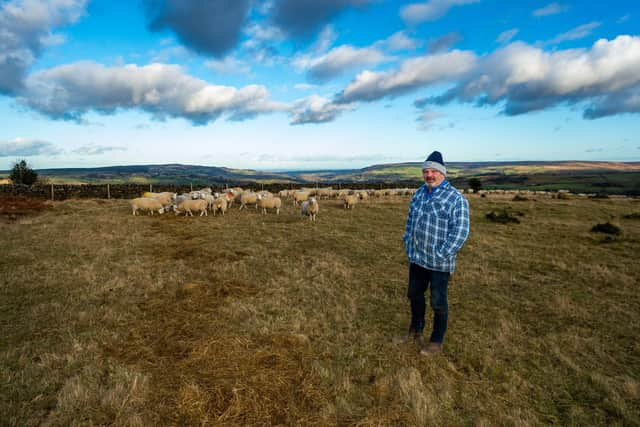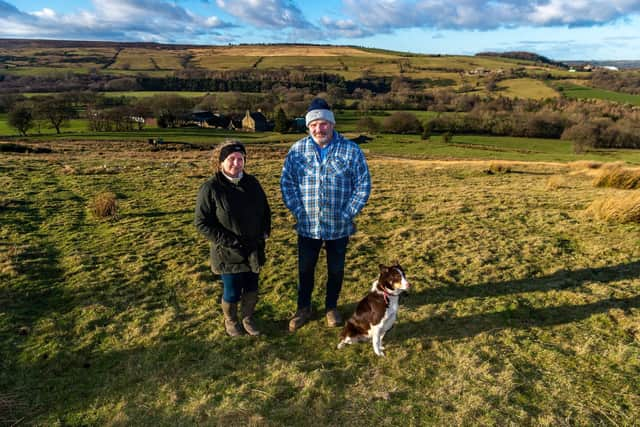Farm of the Week: Cheviot breeders in the North York Moors who other farmers thought had 'lost the plot'
Stephen Hallam and his wife Karen farm at the remote Grange Head Farm, two miles down the end of a valley from Egton Bridge, where they tenant from the Mulgrave Estate across 477 acres of mainly rough grazing, and have grazing rights on 4,500 acres on Egton High Moor right across to Rosedale.
Stephen said the local landscape that was once almost wholly taken up with Swaledale and Mule sheep now includes his and other farmers’ Cheviots too.
Advertisement
Hide AdAdvertisement
Hide Ad“When we first got them it was as though ‘what have the Hallams got these for? They’ll not do any good around here,’ but now there are loads of farmers with them.


“For me it is their hardiness, the way they grow and their cost effectiveness that makes all the difference. Our flock is now all Cheviots and has been for years. We have 1,600 breeding ewes and 1,000 of them are up on the moor where they do well even in the harsh north-easterly winds. They last longer too.
“They don’t need as much feed as when we had the Swaledales and they produce what other Cheviot breeders as well as us are now seeing as better lambs, achieving weights at anywhere between 40-45 kilos.
“We sold all the remainder of our latest crop of lambs destined for the meat trade as stores last year due to the prices. They go on to fatteners who will take them through to around 55 kilos. The ewes are great at producing a very healthy, solid-bodied lamb.”
Advertisement
Hide AdAdvertisement
Hide AdStephen buys new Cheviot tups for his flock from the society breed sales held at Lockerbie and Lairg, way up in the Scottish Highlands, every year. It’s the longest journey he makes, nearly 400 miles, but with good reason.


“The tups sold at both auction marts are the hardiest you will find and at Lairg they are even hardier. We do need that kind of tup up here, but we don’t go silly on price. The highest price we’ve paid is £3,000.”
Stephen said the move towards the North Country Cheviots started when they purchased 170 Cheviot ewe lambs from one of the breed’s best-known names.
“We bought them from Joyce Campbell in Armadale who has been Scottish Sheep Farmer of the Year and we just kept increasing their numbers by breeding more ourselves and decreasing the Swaledales as we grew the Cheviot numbers until we became totally North Country Cheviots.
Advertisement
Hide AdAdvertisement
Hide Ad“We start lambing on April 1 each year for what usually amounts to four weeks. That’s myself, Karen and one of our two sons, Jamie, who runs a digger business the rest of the year apart from April.
“We will have all our sheep scanned next week by Tim Dunn of Bransdale and we normally hit around 155-160 per cent prolificacy overall. The Cheviot is not known for having a lot of lambs.”
Stephen said the saleability of his wether lambs was one of the most immediately noticeable positives of having switched to Cheviots. “We had always struggled selling wether lambs until taking on the Cheviots, which sell really well. We also sell surplus ewe lambs well too.
“We start gathering up our wether lambs on the moor at about the middle of August and that usually means that about three-quarters of the wethers that have grown best can be got away as soon as possible. The smaller ones will grow on to be sold later.”
Advertisement
Hide AdAdvertisement
Hide AdStephen said that he tries to keep back around 400 ewe lambs each year as replacements for the flock as he sells ewes as four-crops. He sells around 250 ewe lambs to other Cheviot and commercial breeders with the remainder of his ewe lambs being sold starting from the end of September, but nothing generally goes through a livestock market.
“Everything goes privately and most of our buyers tend to come here with many buying 30-40 at a time. The reason we don’t generally go to markets is that those that buy Cheviots in any significant number are miles away and as we’re stuck in a corner it takes too long for us to get anywhere regularly.”
This year could be a first for Stephen and Karen. Stephen said they are preparing for a foray into selling rams at the annual Lockerbie sale.
“If all goes according to plan we will be going. We generally keep back around 15-20 ram lambs with a view to then selecting four or five for ourselves. We’ve held back from going up to one of the major sales with any of our own and you can only really go if you have something worthwhile. We’ve been working at it now for a few years. Hopefully, we will have something that looks right.”
Advertisement
Hide AdAdvertisement
Hide AdStephen and Karen moved to Grange Head Farm from near Glossop in Derbyshire where Stephen had been born, the youngest of nine siblings. Stephen said the land is similar to what they farmed in the hills around Chunal.
“We moved here because we wanted our own farm, big enough to bring up our family. The east winds can be a killer and the Beast from the East fettled us a few years ago when we lost around 60 lambs, not from the snow but just how cold it was. “.
Stephen said the farm isn’t all rough grazing and moorland. “We have 150 of our tenanted acres that we can mow and we rent a further 150 acres in the village.”
Stephen was always destined to be a farmer but has found that even with 1,600 breeding ewes there has been a need to diversify.
Advertisement
Hide AdAdvertisement
Hide Ad“Farming was all I ever wanted, as well as family. Karen and I have two other sons, Jack who has a joinery business in Egton Bridge, and John who is studying politics at Teesside University. We have a daughter, Kate, who is still at school.
“I always want most of my income to come from breeding quality sheep, but with us losing the single farm payment we realised we would have to do something else. That’s why we bought two diggers.”
